|
|

This chapter contains step-by-step instructions for configuring and controlling the Cisco 6920 using the RateMux Manager. The chapter contains the following sections:
The RateMux Manager is a web-based user interface which allows you to configure and control the Cisco 6920. Start up the Cisco 6920 by powering up the unit; then launch an Internet browser from your PC. Use the Internet browser to access and use the RateMux Manager web server, which runs in the memory of the PowerPC module of the Cisco 6920.
 |
Note Make sure that the Cisco 6920 is properly installed with all cables connected. Then turn on the Cisco 6920 and wait at least 30 seconds before proceeding. See Chapter 3, "Installing the Cisco 6920" for more information. |
The RateMux Manager runs on a web browser. Start by launching a web browser such as Netscape Communicator or Microsoft Internet Explorer on your computer.
A unique IP address is assigned to each PowerPC module. This IP address is printed on a label on the Cisco 6920. Your web browser uses this address to communicate exclusively with the Cisco 6920 with the corresponding IP address.
To access the RateMux Manager, enter the preassigned IP address in the web browser.
 |
Note For Netscape Users: Enter the Cisco 6920 RateMux multiplexer IP address in the line LOCATION. For Microsoft Internet Explorer Users: Enter the Cisco 6920 IP address in the line LOCATION/URL. |
 |
Note This version of the product does not support Reverse Address Resolution Protocol for automatic assignment of Internet addresses. Cisco recommends using a direct Internet connection as apposed to a proxy server. If your proxy server caches responses from the RateMux, this might yield inaccurate responses. |
After a connection is successfully established with the Cisco 6920, the Transponder Map appears.
 |
Note The time required for the Cisco 6920 to boot, and for the initial connection to be established depends on the number of cards installed in the chassis. The higher the number of cards installed, the longer it will take. |

 |
Note If the web browser indicates that it cannot find the IP address you have entered, verify that you are entering the correct IP address for your network. |
The RateMux Manager is loaded into your PC from memory, displaying the most recently saved configuration.
Step 2 From the Edit menu of the browser, choose Preferences. The Preferences dialog box appears.
Step 3 With the Cisco 6920 address displayed in the Location field of the Home page panel, click Use Current Page.
Step 4 Click Advanced.
Step 5 Click Use Direct Connection.
Step 6 Click OK.
 |
Note You can also bookmark the Cisco 6920 address. Bookmarking works well when multiple Cisco 6920 units are managed from a single browser. |
When you configure the Cisco 6920, you use the RateMux Manager software to confirm and assign transponder feeds, enable channels, and activate and allocate output bandwidth.
To configure transponder inputs and outputs:
Launch the web browser and access the RateMux Manager. If there is no response, wait 5 seconds and try again. (If the browser is already running the RateMux Manager, click Transponder Map on top of the Program Select page). This displays the Transponder Map page. (See Figure 4-2.)

The RateMux Manager scans for and detects all installed video input and output cards. The Transponder Map feature displays the slot and connector of these Input/Output and input cards.
 |
Note The slot number sequence starts from the left side of the back panel and starts at 0. The connector starts from the top connector on the I/O board and starts at 0. (See Figure 4-3.) |
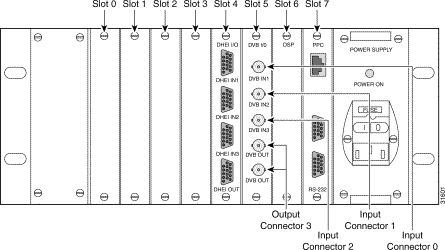
Transponder or program names can be added, changed, or deleted:
To add names, click Add Names. The Add New Names page appears. (See Figure 4-4.)
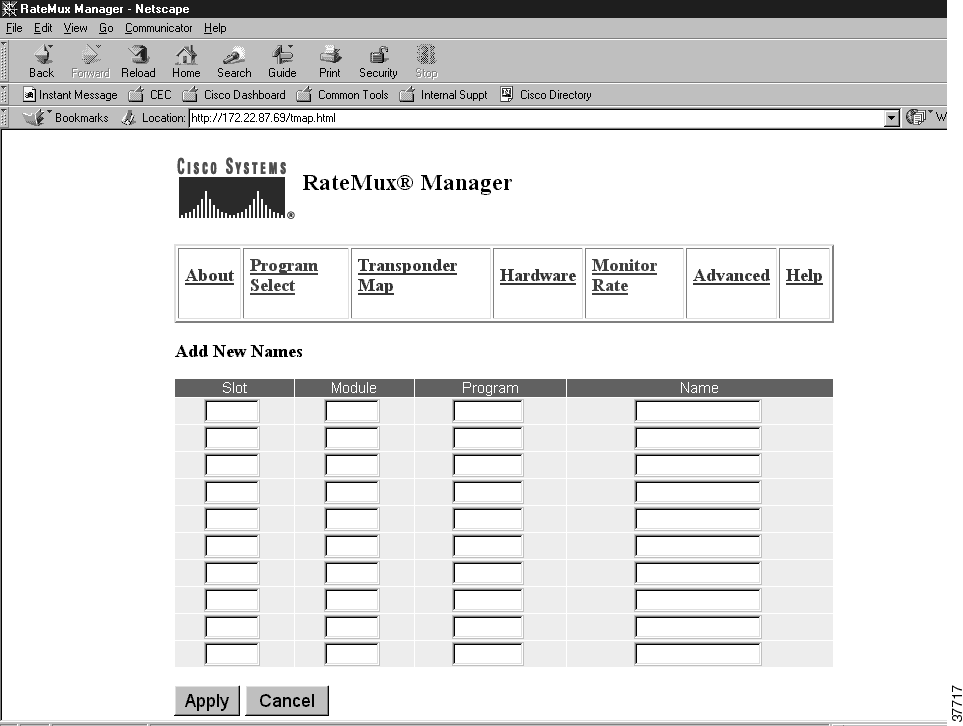
Enter the slot/module number, program number, and the name for the transponder or program, then click Apply. The name is added to the database. A maximum of ten names can be entered at a time. Click Cancel to return to the previous page.
To change the name of a transponder or program, edit the name field then click Apply.
To delete names, select the Delete option of the name to be deleted then click Apply. If the name is a program name, it is removed from the database. If a transponder name is deleted, all program names that belong to that transponder are deleted and the transponder is set to its default name.
The current name database is saved in Flash memory every time the configuration of an output transponder is changed. To list the names stored in the database, select the Display All Transponder Names option, then click Refresh. The page displays both current and previous transponder names. Clicking Refresh without selecting the Display All Transponder Names option (default) displays only the current names. Clicking Refresh with the Display Service Names option selected displays name entries for both transponders and programs. Clicking Refresh without selecting the Display Service Names option (default) displays only the transponder names.
To display the Cisco 6920 hardware configuration, click Hardware on the menu bar at the top of the RateMux Manager page. The Hardware Map appears. (See Figure 4-5.)

The Hardware Map displays the board, slot, and component configuration of your Cisco 6920.
In the sample configuration shown in Figure 4-5, there is a DSP board in slot 3, with three DSP chips. A DVB-ASI I/O board occupies slot 1 with three transponder feeds (input), an onboard DSP, and two output connectors. (The map shows only one output connector, which is Y configured to form two output connectors). The PowerPC board resides in Slot 7.
The DSPs that reside on DSP boards are named using the following convention: s0m0, for slot number (starting with 0) and module number (starting with 0). The module number refers to the physical DSP chip on the DSP card.
Before you can allocate bandwidth, you must first select and enable channels. Click Program Select at the top of the RateMux Manager page. The Program Select page appears. (See Figure 4-6.)
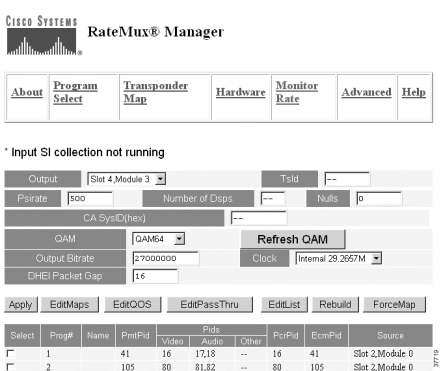
In the Output pull-down menu, select the output card you want to configure.
 |
Note The Program Select pages for DHEI I/O and the DVB-ASI I/O cards differ. The details of each of these pages are discussed in the following subsections. |
When a DHEI I/O card is selected for output, the DHEI I/O Program Select page appears. (See Figure 4-7.)

The Output section of the page contains the following display and input fields:
Output—Displays the slot and connector of the output. Use the pull-down menu to select other cards for configuration.
Tsid—Displays the transport stream ID.
Psirate—Indicates the rate (in milliseconds) at which PSI data is being injected into the video stream.
Number of DSPs—Displays the number of DSPs used for this output.
Nulls—Indicates the minimum number of NULL packets (in bits per second) being inserted into the video stream.
CA SysID—Displays the Conditional Access System ID descriptor. This CA_System ID is needed by the conditional access vendor, and can be changed by entering a new value (hexidecimal) for example, AB 34, in the field. (Two dashes (--) indicates that the original setting should be kept.)
QAM—The QAM pull-down menu allows the selection of two quick-configuration options: QAM64 and QAM256. (See Figure 4-8.)
 |
Note This field does not show the current configured output bit rate and clock settings. It should be used only to set these parameters to the predefined values. |

For each selection the analog channel bandwidth is assumed to be a default of 6 MHz.
Select one of the values. The I/O details for that selection are displayed. Click Apply to configure the I/O card.
Output Bitrate—The Output Bitrate field allows entry of an output bit rate of a value less than the maximum bit rate supported by the DHEI interface. Enter a value and click Apply to configure the I/O card.
DHEI Packet Gap—The DHEI Packet Gap defines the number of bit clocks between MPEG packets on the DHEI output. Allowable values are 0 or 16-271. Enter a value then click Apply to configure the card.
Clock—The Clock pull-down menu allows the selection of the source of the output clock: 38.8107 MHz and 29.2657 MHz Internal or an External clock source. (See Figure 4-9.)
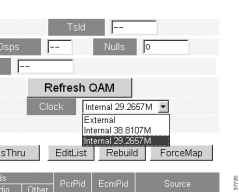
Select the desired value, then click Apply to configure the I/O card.
The buttons on the Program Select Page are as follows:
Apply—Submits selected channels, along with the configuration of that output, to the RateMux Manager for implementation. If conflicts are detected, the proposed configuration is rejected. This feature can be used to deselect all selections for a particular Output by clicking Apply when no programs are selected.
 |
Note When several values are changed, it is only necessary to click Apply once to configure all values. |
EditMaps—Displays the EditMaps page for the same selected channels, which allows editing of the following Program Select fields (for information on PID fields, see the ISO/IEC 13818-1:1994 [E]):
Prog#
ProgPid
VideoPid
AudioPid
OtherPid
EditQOS—Displays the EditQos page for the same selected channels, which allows you to set module routing and allocate channel bandwidth by editing the following Program Select fields:
Qos (Quality of Service)
DSP (Digital Signal Processor)
Source (Transponder input)
EditPassThru—For the same selected channels, allows the passing of low bit-rate CBR streams directly from the Input to the Output without any processing by the Cisco 6920.
EditList—For the same selected channels, allows you to return to edited but not yet applied selections.
Rebuild—Copies the current configuration (as stored in Flash RAM) to the Program Select page for editing. Information about the DSP assignment is not copied from the current configuration. Instead, DSP assignment is always reinitialized to default values ("--"). Click Program Select to start over with a clean slate (no prior configuration selections). This will erase any previous edits.
ForceMap—Lets RateMux Manager use your selections to automatically calculate and resequence PID values. If conflicts are detected, RateMux Manager resolves them. You must still click Apply to reconfigure.
 |
Note The Program Select function (at the top of the page) always refreshes the input channel information and erases any unapplied edits within the current EditMaps, EditQos, or EditPassThru pages. This function applies to the Program Select page. This can be useful if you want to "start from scratch." Simply select Apply with no programs selected and no changes to other information, and the RateMux Manager will start fresh. |
You can select and enable channels on the Program Select page. All other fields are passive. You must go to either the EditMaps or EditQos page to edit these fields.
When a DVB-ASI I/O card is selected for output, the DVB-ASI I/O Program Select page appears. (See Figure 4-10.)
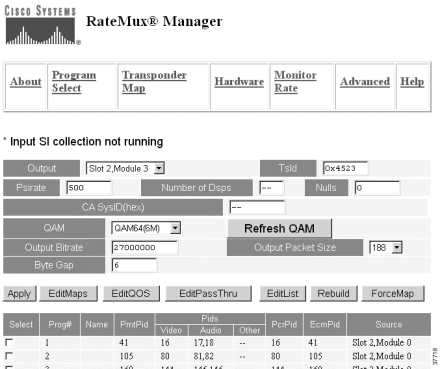
The Output section of the page contains the following display and input fields:
Output—Displays the slot and connector of the output. Use the pull-down menu to select other cards for configuration.
Tsid—Displays the transport stream ID.
Psirate—Indicates the rate (in milliseconds) at which PSI data is being injected into the video stream.
Number of DSPs—Displays the number of DSPs used for this output.
Nulls—Indicates the minimum number of NULL packets (in bits per second) being inserted into the video stream.
CA SysID—Displays the Conditional Access System ID descriptor. This CA_System ID is needed by the conditional access vendor, and can be changed by entering a new value (hexidecimal) for example, AB 34, in the field. (Two dashes (--) indicates that the original setting should be kept.)
QAM—The QAM pull-down menu allows the selection of four quick-configuration options: QAM64(6M), QAM256(6M), QAM64(8M), and QAM256(8M). (See Figure 4-11.)
 |
Note This field does not show the current configured output bit rate and clock settings. It should be used only to set these parameters to the predefined values. |
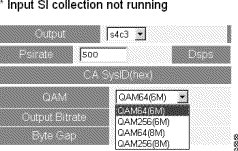
Select one of the values. The I/O details for that selection are displayed. Click Apply to configure the I/O card.
Output Bitrate—The Output Bitrate is used to calculate the number of 27 MHz clocks between output MPEG packets. This bit rate is based on 188-byte packets.
Byte Gap—The Byte Gap defines how many Asynchronous Serial Interface (ASI) null bytes to insert between MPEG bytes. The MPEG transport stream is output with the defined number of ASI null bytes following each byte of MPEG data. Any additional bandwidth is then filled with ASI null bytes between MPEG packets. A Byte Gap of 0 puts all ASI nulls between packets, and makes delivery as bursty as possible. A larger Byte Gap reduces the burstiness of transmission of packets. The default value is 3. Enter a value from 0 to 32, then click Apply to configure the card.
Output Packet Size—The Packet Size pull-down menu allows the selection of either 188-byte mode or 204-byte with 16 null bytes. (See Figure 4-12.)

Select the desired value, then click Apply to configure the I/O card.
The buttons on the Program Select Page are as follows:
Apply—Submits selected channels, along with the configuration of that output, to the RateMux Manager for implementation. If conflicts are detected, the proposed configuration is rejected. This feature can be used to deselect all selections for a particular Output by clicking Apply when no programs are selected.
 |
Note When several values are changed, it is only necessary to click Apply once to configure all values. |
EditMaps—Displays the EditMaps page for the same selected channels, which allows editing of the following Program Select fields (for information on PID fields, see the ISO/IEC 13818-1:1994 [E]):
Prog#
ProgPid
VideoPid
AudioPid
OtherPid
EditQOS—Displays the EditQos page for the same selected channels, which allows you to set module routing and allocate channel bandwidth by editing the following Program Select fields:
Qos (Quality of Service)
DSP (Digital Signal Processor)
Source (Transponder input)
EditPassThru—For the same selected channels, allows the passing of low bit-rate CBR streams directly from the Input to the Output without any processing by the Cisco 6920.
EditList—For the same selected channels, allows you to return to edited but not yet applied selections.
Rebuild—Copies the current configuration (as stored in Flash RAM) to the Program Select page for editing. Information about the DSP assignment is not copied from the current configuration. Instead, DSP assignment is always reinitialized to default values ("--"). Click Program Select to start over with a clean slate (no prior configuration selections). This will erase any previous edits.
ForceMap—Lets RateMux Manager use your selections to automatically calculate and resequence PID values. If conflicts are detected, RateMux Manager resolves them. You must still click Apply to reconfigure.
 |
Note The Program Select function (at the top of the page) always refreshes the input channel information and erases any unapplied edits within the current EditMaps, EditQos, or EditPassThru pages. This function applies to the Program Select page. This can be useful if you want to "start from scratch." Simply select Apply with no programs selected and no changes to other information, and the RateMux Manager will start fresh. |
You can select and enable channels on the Program Select page. All other fields are passive. You must go to either the EditMaps or EditQos page to edit these fields.
When you enable channels, you perform a number of important functions:
Select the output port to use for this output video stream. Recall the output stream from the Transponder Map page. (See Figure 4-2.)
The Cisco 6920 supports one or two outputs on two different I/O cards. To edit or review a specific output:
 |
Note The default output is the one closest to slot 0. |
Step 2 Change the Output field to the desired output name (example: Slot 2, Module 3). The Output field always ends in 3.
Step 3 Click EditList to change to the desired output.
To enable channels:
Step 2 Click Program Select to display the Program Select page.
Step 3 Each input source is highlighted a different color. You can determine the input source by referencing the Source column.
Step 4 Click check boxes in the Select column that correspond to the video PID or audio PID of the desired programs.
Step 5 Review the program numbers of the channels you selected. You might have duplicate program numbers from different input sources. You must modify the program number of one of these channels or the RateMux Manager will issue an error message. You can have the RateMux Manager reassign the Program numbers simply by clicking the ForceMap selection; or you can reassign the Program numbers manually in the EditMaps page. (See Figure 4-13.)
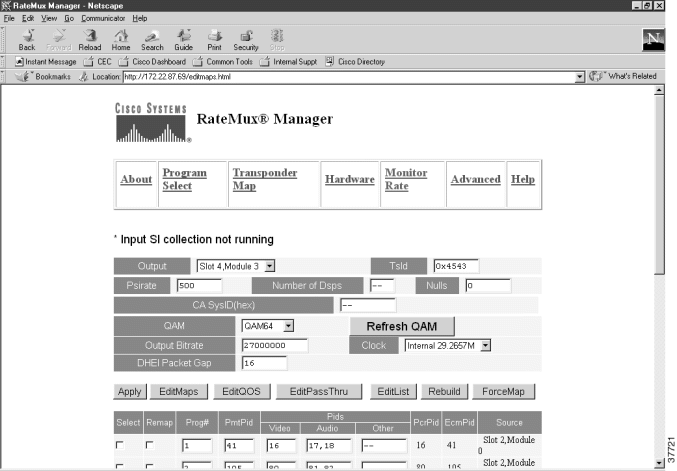
Step 6 When you are satisfied with the channel lineup you have selected, click Apply to submit your changes. If video was running, it will go blank for a few seconds while the Cisco 6920 RateMux multiplexer reassigns the channel setup.
RateMux Manager assigns the transponder source and output to the channel. If you receive a warning notifying you of conflicts in channel selection, scroll down the Program Select page to check other transponder sources and channel selections, make changes accordingly, and then repeat this procedure. Otherwise, click ForceMaps to resolve conflicts by letting RateMux Manager resequence all selected channels and PID values.
 |
Note When you use the ForceMaps feature, PIDs are assigned to channels in groups of 64, starting with a base of 0. For each channel from the base, the 16th PID is assigned to video and the 17th PID to audio. The PCR follows the video PID. The PMT PID is assigned base +41. |
You can use the Rebuild feature to save time and keystrokes when making changes to configurations. As mentioned earlier, when you click Rebuild, the RateMux Manager writes the current configuration (channel selections, Editmaps, and QoS parameters) to the Program Select page, so you don't have to reenter parameters. This is helpful when you want to change parameters. The Rebuild feature recalls the latest applied set of parameters. If you have made changes to the parameters but have not yet clicked Apply, and you want to maintain those new parameters, you might want to select EditList.
Use the EditList feature when you select an output and you want to make changes to the channel selections. When you click EditList, the RateMux Manager recalls the current channel lineup for you to review and edit.
The RateMux Manager can dynamically allocate bandwidth. By default, all channels are eligible for reassignment, with a quality of service (QoS) rate reduction value of Medium. You can also assign a QoS value to channels. These assignments rank channels in terms of eligibility for bandwidth swapping.
Click EditQOS on the Program Select page to display the EditQOS page. (See Figure 4-14.)
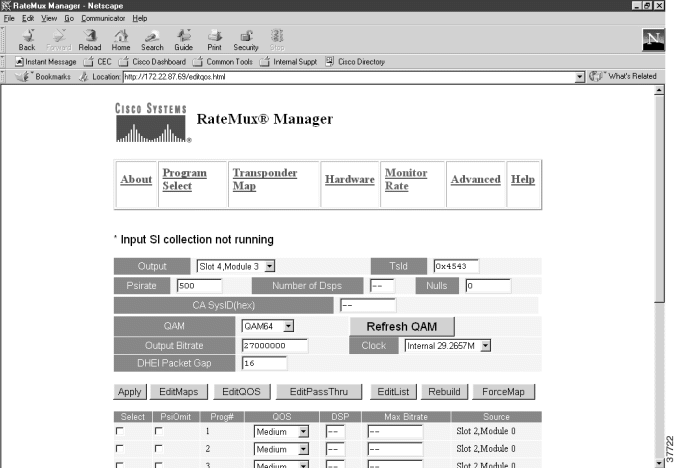
The EditQOS page has the following features:
When you select QoS, you assign bandwidth allocation priorities to discrete channels. Your QoS selections determine how the RateMux Manager allocates bandwidth. You make these selections on the EditQOS page.
To select quality of service:
Step 2 On the Program Select page, click EditQOS. The EditQOS page appears.
Step 3 For a selected channel, click the QOS pull-down menu. (See Figure 4-15.)
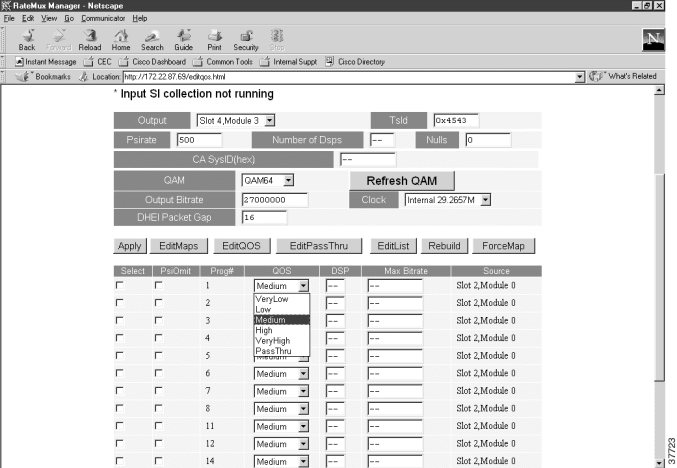
Step 4 Choose a QoS from the menu. The choices are:
Step 5 Optionally, click the PsiOmit check box to remove program information about this channel from the output stream. This parameter applies only if the PSIrate is not 0.
Step 6 For each selected channel, enter "--" in the DSP field to let the RateMux Manager assign an available DSP for that channel. By default, the RateMux Manager assigns one DSP to each channel in a round-robin fashion until DSPs are allocated for all channels. The system assigns no more than three programs to a DSP.
OR
Enter a number in the DSP field. The RateMux Manager interprets DSP numbers as follows: All programs with the same number are assigned to the same DSP, and no other programs are assigned to that DSP. In this case, the limit of three programs per DSP is not enforced. In effect, you are setting aside a DSP to handle all the programs (and only the programs) with that number. The DSP allocation is displayed in the Output Report.
Step 7 Enter a number (in bits per second) in the Max Bitrate field to set a maximum bit rate for that particular stream. That stream's bit rate is limited to the specified value, ensuring that the bit rate at the output of the Cisco 6920 does not exceed the specified value for that stream.
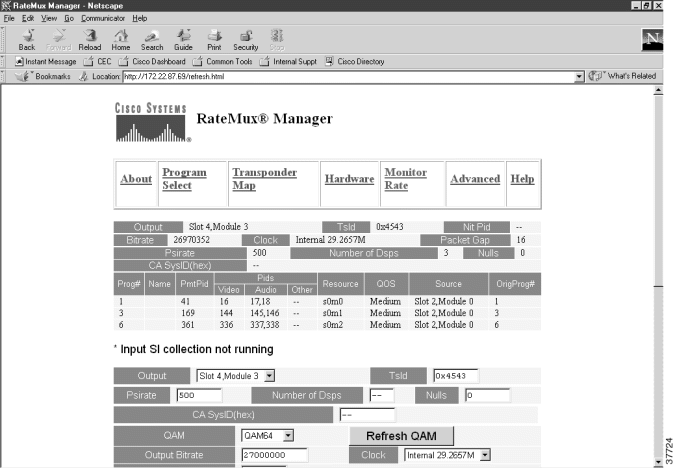
Step 8 Click Apply. RateMux Manager assigns the QoS selections to the selected channels and displays the results in an Output Report on the Program Select page. (See Figure 4-16.) If you click Apply and RateMux Manager detects a conflict, the submitted selections are rejected. Try resolving the conflicts, or click ForceMap to allow the RateMux Manager to resolve them for you. Then click Apply.
When you remap PIDs, you reassign values that correspond to the PAT and PMT tables as defined in the MPEG-2 standard (see the ISO/IEC 13818-1 MPEG-2 standard). You can remap channels, program PIDs, video PIDs, and audio PIDs precisely to accommodate bandwidth swapping. Or you can let the RateMux Manager perform remapping for you.
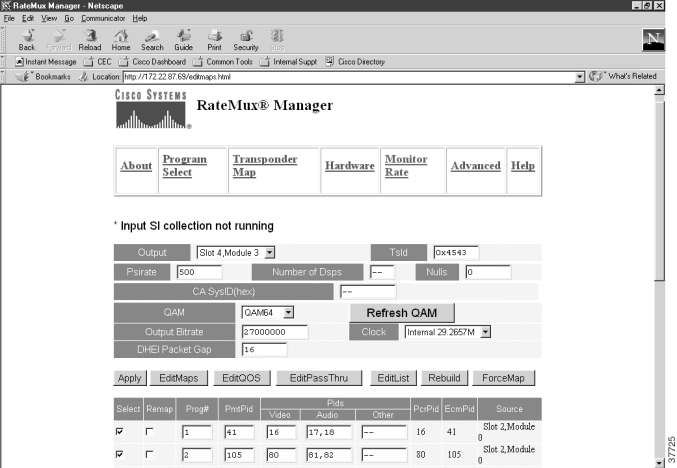
To remap PIDs:
Step 2 Click check boxes in the Select column that correspond to the channel numbers you want to remap.
Step 3 Click check boxes in the Remap column to designate channels for remapping.
Step 4 If changing channels, enter the new channel in the Prog# column.
Step 5 If dropping a PID from a program selected for output, remap it to "--".
Step 6 If changing PIDs, enter the new PID values in the ProgPid, VideoPid and AudioPid columns, or click the Remap check box for the channel to let RateMux Manager determine new PID values.
Step 7 Click Apply.
Step 8 RateMux Manager remaps according to your selections. If you click Apply and RateMux Manager detects conflicts, the system attempts to resolve conflicts using those channels with the Remap setting turned on. If conflicts cannot be resolved, the submitted selections are rejected. Try resolving the conflicts, or click ForceMap to allow the RateMux Manager to resolve them for you. Then click Apply.
 |
Note You cannot manually remap the PCR (Program Check Reference). This value changes only when you execute a ForceMap, which resequences all the selected programs and PID values. In the case of ForceMap, the PCR points to the video PID. When you or the RateMux Manager alter the PID value of an elementary stream in a program that is used as the PCR PID, then the PCR PPDI is automatically changed to reflect your selection. |
The EditPassThru feature allows low bit-rate (less than 256 kbps) CBR video streams for any channel to be passed directly from the input source to the output destination without any processing.
To edit passthrough PIDs:
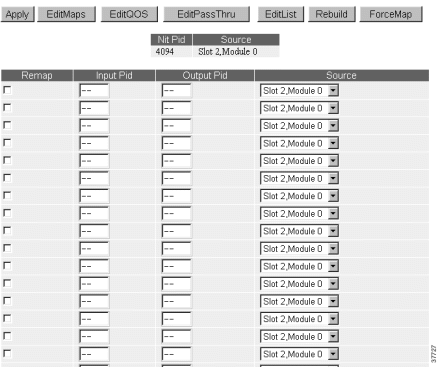
Step 2 Scroll down the page and locate the table of read-only Nit Pids for each input.
Step 3 To select a PassThru PID, simply enter the input PID, the output PID (only needed if different from the input PID), the input that PID should be extracted from, and whether the Cisco 6920 is allowed to remap the Output PID to a different value in case of conflict (Remap box).
Step 4 If a PassThru PID is recognized as a nit PID from the NitPid list, then the Cisco 6920 assumes that the PID should be used as the nit PID.
The Monitor Rate feature allows you to view a bar chart of input and output bit rates for each video stream selected in your channel lineup. The total input and output bit rates are also calculated and displayed. (See Figure 4-19.)

The bar chart can be customized by choosing colors for input/output bars and by changing the scale for both the individual channels and the bit-rate totals. To reduce the scale, click < to modify the scale of the individual video stream display, or click << to modify the totals display. To increase the scale, click > or >>.
The Advanced page enables or disables the collection of table information, and allows the resetting of the Cisco 6920. (See Figure 4-20.)

Checking Disable PSI & SI collections or Disable SI collection only stops the collection of input PSI and SI (or SI only) data and causes the Cisco 6920 to use the last collected data.
When the Disable Private Table collection box is not checked, in addition to collecting PAT and PMT of table ID 0x2, the Cisco 6920 starts collecting tables that are carried in the transport packets with the same PID as PMT_PID and have table IDs of 0x40, 0x41, 0xc, and 0xc1. These special tables are collected for every incoming program. The collection process usually takes 15 seconds. If every incoming program contains all four of the special tables, the collection finishes in under 15 seconds. Otherwise, the collection times out in 15 seconds. For that reason, after enabling the private table collection, wait at least 30 seconds before clicking Program Select to start configuring the output transponder. Clicking Program Select causes the Cisco 6920 to copy its latest snapshot of the PSI data (including the special tables) to the EditList.
Clicking Apply to commit the output transponder configuration, causes the snapshot of the special tables to become part of the Cisco 6920's output PSI data.
Clicking System Reset activates the chassis reset circuitry equivalent to a Power Off, Power On sequence.
The About page provides information concerning the software version installed on the Cisco 6920, along with the IP and Ethernet addresses being used by the unit. (See Figure 4-21.)
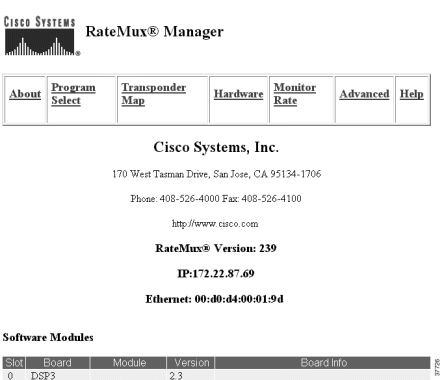
Information concerning the installed Cisco 6920 cards and the software module versions on those cards is displayed in a version table on the lower part of the screen. The version table is organized by card, listing the card, followed by all the software modules on that card. (See Figure 4-22.)
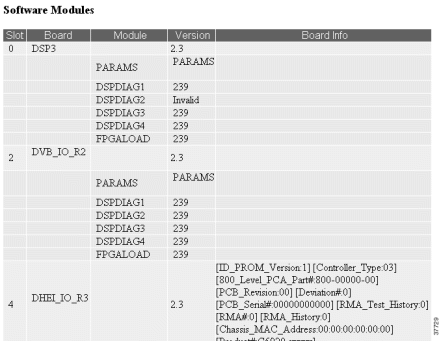
The Help page (see Figure 4-23) provides a link to the latest user documentation for the Cisco 6920 on the Cisco web page, Cisco Connection Online.
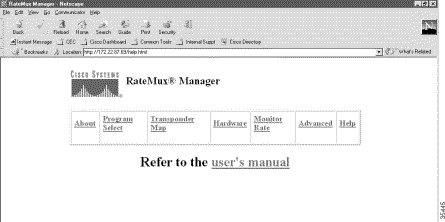
Click user's manual to access these documents that can be viewed and downloaded in either HTML or PDF format.
![]()
![]()
![]()
![]()
![]()
![]()
![]()
![]()
Posted: Thu Mar 29 17:13:24 PST 2001
All contents are Copyright © 1992--2001 Cisco Systems, Inc. All rights reserved.
Important Notices and Privacy Statement.